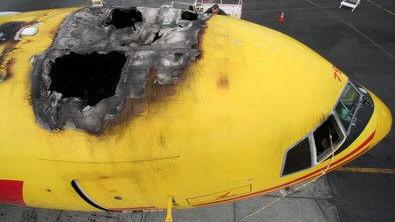
| NEWSROOM |
|
|
 |
|
|
|
|
|
|||
|
By Bill Goldston |
||||
 |
February 22, 2010
- The Air Line Pilots Association, Int’l (ALPA), commends the National
Transportation Safety Board (NTSB) for continuing to use its Most Wanted
Transportation Safety Improvements to draw attention to many of the most
serious safety challenges the
“We are gratified
that the NTSB continues to push the FAA to enhance safety in critical
areas, including the need to take on pilot fatigue, reduce runway
incursions and excursions, and provide better guidance to ensure safe
flight in icing conditions,” said Capt. John Prater, ALPA’s president.
“ALPA strongly supports the Board’s call for expedited action to better
safeguard passengers, crews, and cargo against these threats.”
|
|||
|
On June 28,
2008 at approximately 10:15 pm pacific daylight time, Airborne
Express flight 1611, a Boeing 767 aircraft, registration N799AX,
caught fire just aft of the cockpit area while the flightcrew
were preparing to start the engines. The airplane was parked at
plot 11 at the |
||||
|
In addition, the
Association applauds the NTSB’s continued focus on efforts to provide
safer operations on and around runways. ALPA continues to be an industry
leader in work to eliminate runway incursions and excursions.
Technologies such as ADS-B and cockpit moving map displays, combined
with runway status lights and enhanced runway markings, will help pilots
safely navigate increasingly complex and congested airports.
Prater said that
ALPA pilots are encouraged by the FAA’s commitment to increase the
number of airports with runway status lights in 2011, but he underscored
that the airline industry must continue to pursue the range of high- and
low-tech solutions to making runways as safe as possible. |
||||
|
While supporting
nearly all the NTSB’s Most Wanted Safety Improvements, ALPA, the world’s
largest non-governmental aviation safety organization, remains adamantly
opposed to the Board’s recommendation for the use of cockpit image
recorders.
“Well-proven and
far superior methods exist to gather safety information without the
threat of becoming the distraction in the cockpit that video cameras
pose,” concluded Prater. “Cameras also hold the potential to compromise
the accident investigation process and invade privacy. In addition, the
absence of international safeguards makes it a virtual certainty that
such data would be misused. These powerful drawbacks make it clear that
cockpit image recorders have no place in a commitment to advancing
aviation safety.”
NTSB Most Wanted
List For Aviation Actions Needed By FAA
Require Image
Recorders
• Install
crash-protected image recorders in cockpits to give investigators more
information to solve complex accidents.
Improve the Safety
of Emergency Medical Services (
• Conduct all
flights with medical personnel on board in accordance with stricter
commuter aircraft regulations.
• Develop and
implement flight risk evaluation programs for
• Require
formalized dispatch and flight-following procedures including up-to-date
weather information.
• Install terrain
awareness and warning systems (TAWS) on aircraft used for
Improve Runway
Safety
• Give immediate
warnings of probable collisions/incursions directly to flight crews in
the cockpit.
• Require specific
air traffic control (ATC) clearance for each runway crossing.
• Require
operators to install cockpit moving map displays or an automatic system
that alerts pilots when a takeoff is attempted on a taxiway or a runway
other than the one intended.
• Require a
landing distance assessment with an adequate safety margin for every
landing.
Reduce Dangers to
Aircraft Flying in Icing Conditions
• Use current
research on freezing rain and large water droplets to revise the way
aircraft are designed and approved for flight in icing conditions.
• Apply revised
icing requirements to currently certificated aircraft.
• Require that
airplanes with pneumatic deice boots activate the boots as soon as the
airplane enters icing conditions.
Improve Crew
Resource Management
• Require commuter
and on-demand air taxi flight crews to receive crew resource management
training.
• Reduce Accidents
and Incidents Caused by Human Fatigue in the Aviation Industry
• Set working hour
limits for flight crew s, aviation mechanics, and air traffic
controllers based on fatigue research, circadian rhythms, and sleep and
rest requirements.
• Develop fatigue
awareness and countermeasures training program for controllers and those
who schedule them for duty. • Develop guidance for operators to establish fatigue management systems, including a methodology that will continually assess the effectiveness of these systems.
Founded in 1931,
ALPA is the world’s largest pilot union, representing more than 53,000
pilots at 37 airlines in the |
| ©AvStop
Online Magazine
Contact
Us
Return To News
|
|